ALSACAT-014-07-02-COLMAR-1
A man reported to GEIPAN using their sighting report form a luminous phenomenon in the sky of Colmar on July 2, 2014.
As he gazed from the south window of his apartment on or near Rue de l'Est to spot the constellation of Hercules and then try to observe the famous star cluster Messier 13 there, his gaze stopped on a set of light which made a slow movement towards the zenith.
At first he thought he recognized a kite in the shape of a flying wing. The phenomenon seemed to him to measure barely less than a meter in size and seemed to move about ten meters above the roofs.
As the observation went on, he revised his assessment because a distance was in fact not really estimable. After a moment, he saw that it was a coherently advancing set of lights. He observed very carefully and realized that it could not be a kite, because the wind was not perceptible, and no thread was visible. Furthermore, he began to imagine that the phenomenon was possibly further away than he initially estimated, implying a larger size, something he found hard to believe.
He also noticed the complete lack of noise from the phenomenon. As there was no car passing in the rue de l'Est at that time, a fairly significant silence made it possible to effectively recognize that the phenomenon was apparently silent.
The lights were white, each exceeding in brightness the combined magnitude of the three stars of the great summer triangle (the stars Véga, Altaïr et Deneb). The magnitude of each of these lights must have been triple or quadruple the magnitude of these three stars combined. The lights were round, even if their roundness was not obvious to perceive. Confusion with stars was therefore excluded for him on several counts.
He couldn't make out whether a structure connected these lights; which seriously confused him. The lights seemed to him to be assembled in several straight lines, but this symmetry of the beginning of the observation then "deteriorated". At first, the lights were assembled in the center in the shape of a triangle or a diamond, but two "straight lines" extended beyond the "triangle". The set it formed was therefore difficult to define in simple geometric terms.
At first, he had assumed that it was a single phenomenon, but after the strange recomposition of the phenomenon during the second half of the observation, he wondered, just after the observation, whether it was not rather a group of phenomena.
Indeed, after about 20 seconds, he had begun to recognize that the lights were certainly united, but that their relative distance was changing. This was when he tried to count the lights, but the change of the set only allowed him to estimate that there were a dozen or fifteen.
He had then thought of a "model craft whose structure was in the process of collapsing", and expected to eventually see the phenomenon fall to the ground, insofar as a weakness in the structure of a model craft is always fatal. But that didn't happen.
The phenomenon seemed to him, simultaneously with the recomposition of positions, to bend his trajectory very slightly towards the south. The lights seemed to maintain the same altitude, however, despite the recomposition of the position of some. The phenomenon slowly disappeared by the conjunction of the distance and the halo of the city of Colmar which it seemed to fly over.
The sighting lasted about a minute. He had checked the time on his cellphone just after the sighting, it was then 11:00 p.m.
A look at the leaves of the surrounding trees showed him that there was intermittently a very light breeze circulating between the buildings. Shortly after midnight, the weather forecast indicated a north/northeast wind. Having a good memory of the size of the phenomenon in relation to its visual context, he had returned one hour after the observation to the same place and estimated that the object had an angular size barely less than the width of the palm outstretched at arm's length.
He had written his report just after the sighting, answered with great care all the questions of the GEIPAN form, and made a sktech of the layout of the lights:
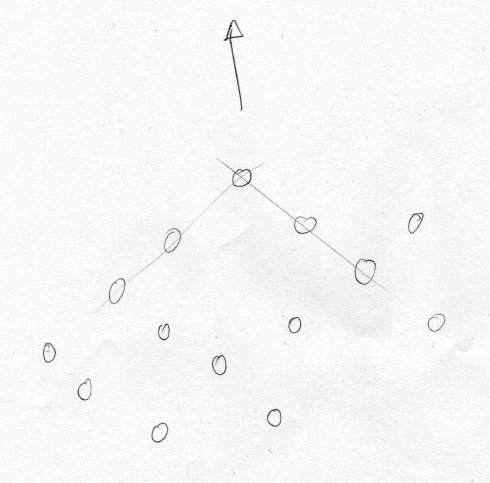
|
A check the next morning with a compass had enabled him, thanks to his memory of the positioning of the buildings, to determine that the phenomenon had circulated along an east-to-west or east-north-east to west-south-west axis. The compass clinometer allowed him to determine that the phenomenon had disappeared at about 30° above the horizon.
A few weeks later, he had remembered a detail: the lights had a slight flicker. This detail had seemed insignificant to him at the time because it was banal, but he later remembered that some stars do not sparkle (in particular the planets): it seemed important to him to add this detail, "however insignificant it nay be."
The GEIPAN noted the high quality of the testimony; which made them think of observing luminous balloons or Chinese lanterns carried by the wind, probably released nearby at a private party.
The GEIPAN noted that the movement was from East to West, that the wind recorded in Colmar at this time was weak, from the North sector, North-East a little earlier, which is more or less compatible with this displacement, taking into account the variability of the wind at low altitude, and the impossibility for the witness to judge the distancing or approach of the lights over such a short time; which can explain the difference in direction.
| Date: | July 2, 2014 |
|---|---|
| Time: | 10:59 p.m. |
| Duration: | 1 minute. |
| First known report date: | July 2, 2014 |
| Reporting delay: | Hour, hours. |
| Department: | Haut-Rhin |
|---|---|
| City: | Colmar |
| Place: | From apartment's south window near rue de l'Est. |
| Latitude: | 48.077 |
| Longitude: | 7.364 |
| Uncertainty radius: | 500 m. |
| Number of alleged witnesses: | 1 |
|---|---|
| Number of known witnesses: | 1 |
| Number of named witnesses: | 1 |
| Witness(es) ages: | Adult or aged. |
| Witness(es) types: | Resident. |
| Reporting channel: | To the GEIPAN using their report form. |
|---|---|
| Type of location: | From apartment window. |
| Visibility conditions: | Night. |
| UFO observed: | Yes. |
| UFO arrival observed: | No. |
| UFO departure observed: | Yes. |
| Entities: | No |
| Photographs: | No. |
| Sketch(s) by witness(es): | Yes. |
| Sketch(es) approved by witness(es): | Yes. |
| Witness(es) feelings: | Puzzled. |
| Witnesses interpretation: | Unidentified, not kite. |
| Hynek: | NL |
|---|---|
| ALSACAT: | Chinese lanterns. |
[Ref. gei1:] GROUPE D'ETUDES ET D'INFORMATIONS SUR LES PHENOMENES AEROSPATIAUX NON IDENTIFIES (G.E.I.P.A.N.):
|
COLMAR (68) 07/02/2014 |
|
| Observed on: | 07/02/2014 |
| Region: | Alsace |
| Department: | Rhin (Haut) |
| Class: | B |
| Summary: | Observation of the displacement of many white luminaries in the night sky: probable observation of Chinese lanterns or lighted balloons carried by the wind. |
| Description: |
This testimony of great quality describes the observation at 10:59 p.m. of a group of white lights (about fifteen) silently crossing part of the sky in one minute. The witness describes the gradual disappearance of the phenomenon; this testimony is reminiscent of the observation of luminous balloons or Chinese lanterns carried by the wind, probably released nearby at the end of a private party. Displacement is observed from East to West (see diagram of the witness) The wind recorded at Colmar at 11 p.m. is weak, from North (North East a little earlier): the weather is almost compatible with this displacement; the variability of the wind at low altitude, and the impossibility for the witness to judge the distance or proximity of the lights over such a short time may explain this difference in direction. The GEIPAN classifies this case "B": probable observation of Chinese lanterns or luminous balloons carried by the wind. |
| Report: | None. |
| Details of the testimony | |
| Witness | |
| Date of the observation | 07/02/2014 |
| Document number | |
| Age | |
| Profession | |
| Sex | Male |
| Reaction | |
| Credibility | |
| Conditions | |
| Environment | |
| Weather conditions | |
| Hour ot the observation | Numbered: 10 p.m. - 00 p.m. |
| Reference frame | |
| Distance between phenomenon and witness | |
| Start of the observation | |
| End of the observation | |
| Localization | |
| Angle of the site | |
| Direction of observation | |
| Heading | |
| Trajectory | |
| Nature of the observation | Descriptive terms (lights, etc) |
| Characteristic of the observation | Multiple |
| Global shape | Round, circular, ball |
| Color | White (light colored) |
| Apparent size | |
| Apparent speed | |
| Noise | Silent |
| Effect on the environment | |
| Number | 3 |
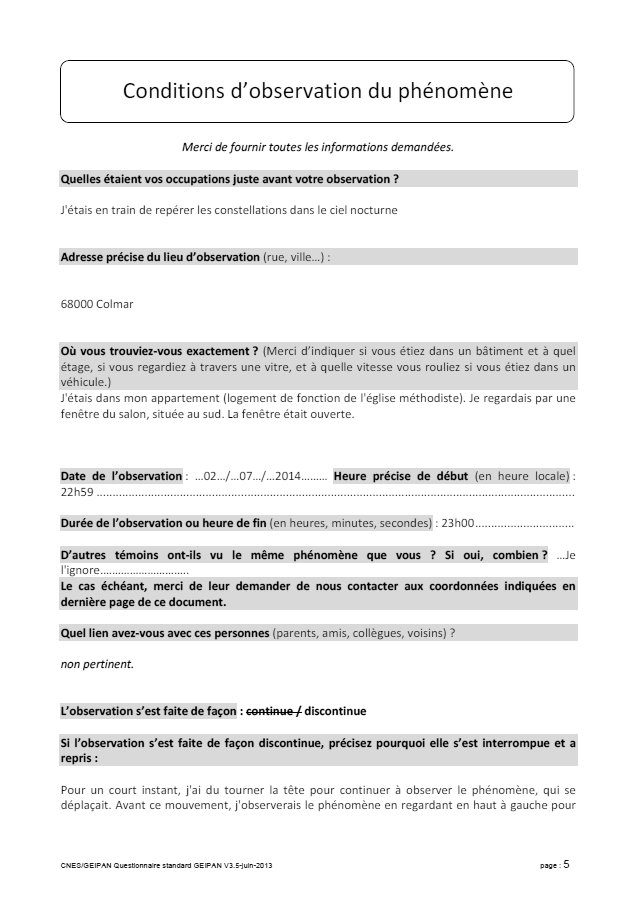
|
Madam, Sir,
You have witnessed directly, on French territory, an aerospace phenomenon that has intrigued you and you want to understand what you have seen.
In order to answer your questions, the National Center for Space Studies and its specialized service GEIPAN offer you a two-step approach:
- The questionnaire is individual and must be completed by the direct witness
- The questionnaire should be about only one observation at a time
Your testimony is important and perhaps unique. It will consist of telling the story of your observation, answering specific questions, making drawings and sketches or attaching photographs to further refine your description.
It is imperative that you adhere to the instructions mentioned at each step so that we can gather as much information as possible about the observed phenomenon. You must not be afraid to tell us about it, nor to feel ridiculous, we are used to collecting this type of testimony.
The conclusions of our investigation will be transmitted to you personally. Once anonymized, your testimony will be published on our website (www.geipan.fr), "Case Search" tab in the menu bar.
We thank you in advance for the contribution you make to our work.
The head of GEIPAN
[]
GEIPAN
Centre national d'études spatiales
DCT/DA/GEIPAN
18 Avenue BELIN 31401 TOULOUSE CEDEX 9
05 61 27 48 01 - geipan@cnes.fr
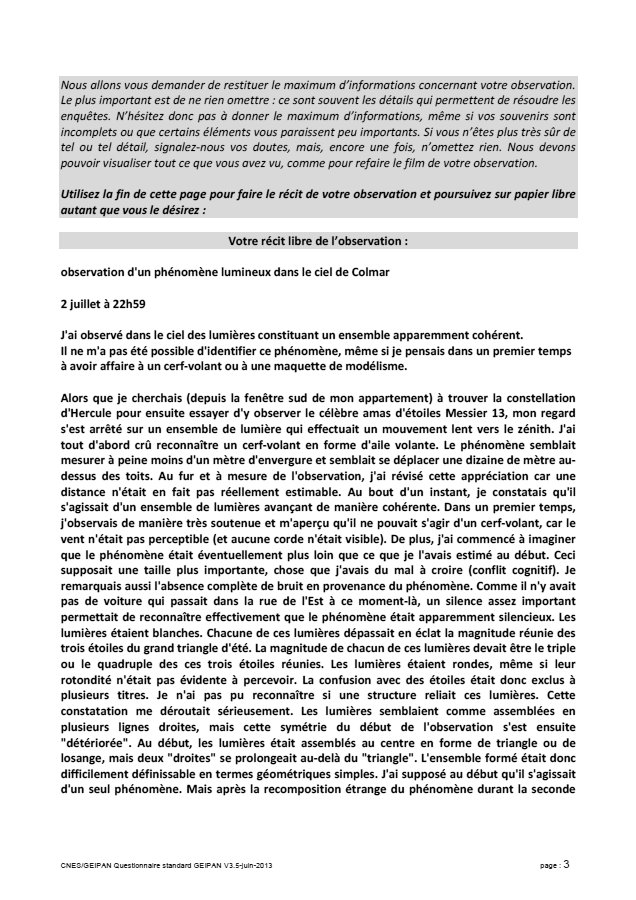
|
We will ask you to provide as much information as possible about your observation. The most important thing is to leave nothing out: it is often the details that make it possible to solve the investigations. Do not hesitate to give the maximum of information, even if your memories are incomplete or that certain elements seem to you not important. If you are not sure about this or that detail, tell us your doubts, but, again, do not omit anything. We need to be able to visualize everything you've seen, like re-doing the movie of your observation. Use the end of this page to tell the story of your observation and continue on free paper as much as you want:
Your free account of the observation:
observation of a luminous phenomenon in the sky of Colmar
July 2 at 10:59 p.m.
I observed in the sky lights constituting an apparently coherent whole. It was not possible for me to identify this phenomenon, even if I thought at first to deal with a kite or model.
As I searched (from the south window of my apartment) to find the constellation of Hercules and then try to observe the famous Messier 13 cluster of stars, my eyes stopped on a set of light that performed a slow motion towards the zenith. I first thought I recognized a flying kite. The phenomenon seemed to measure barely less than one meter wingspan and seemed to move about ten meters above the roofs. As the observation progressed, I revised this assessment because a distance was in fact not really estimable. After a moment, I noticed that it was a set of lights advancing in a coherent manner. At first, I observed very strongly and noticed that it could not be a kite, because the wind was not perceptible (and no rope was visible). In addition, I began to imagine that the phenomenon was eventually beyond what I had estimated at the beginning. This involved a larger size, something I had difficulty believing (cognitive conflict). I also noticed the complete absence of noise from the phenomenon. Since there was no car on rue de l'Est at that time, a fairly significant silence made it possible to recognize that the phenomenon was apparently silent. The lights were white. Each of these lights surpassed the combined magnitude of the three stars of the great summer triangle. The magnitude of each of these lights was to be triple or quadruple of these three stars combined. The lights were round, although their roundness was not obvious to perceive. The confusion with stars was therefore excluded in several ways. I could not recognize whether a structure was linking these lights. This finding baffled me seriously. The lights seemed to be assembled in several straight lines, but this symmetry of the beginning of the observation then "deteriorated". At first, the lights were assembled at the center in the shape of a triangle or diamond, but two "straight" lines extended beyond the "triangle". The set formed was therefore difficult to define in simple geometric terms. I supposed at the beginning that it was a sngle phenomenon But after the strange rearrangement of the phenomenon during the second
CNES/GEIPAN Standard questionnaire GEIPAN V3.5-June-2013 page: 3
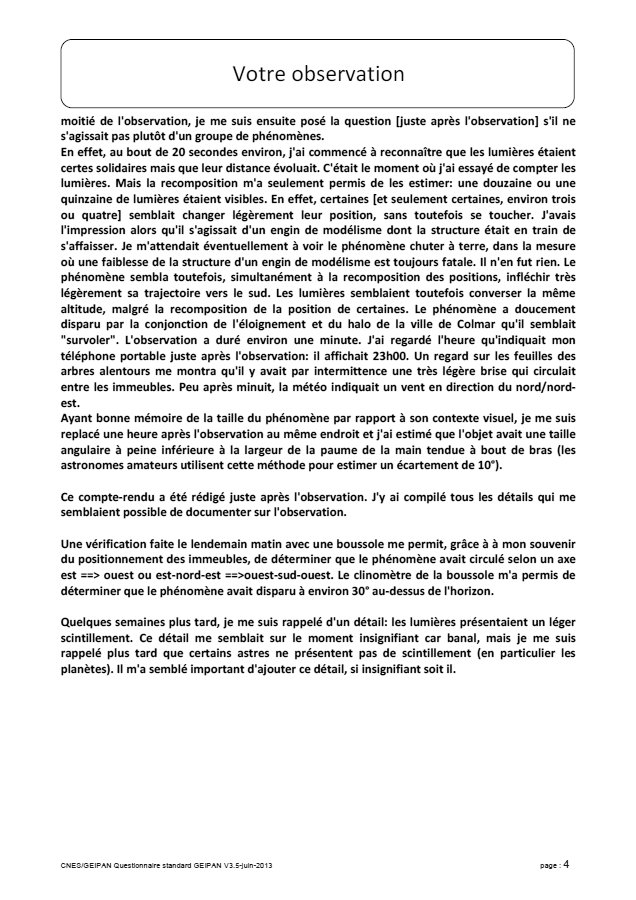
|
half of the observation, I then asked myself the question (just after the observation) whether it was not rather a group of phenomena.
Indeed, after about 20 seconds, I began to recognize that the lights were certainly linked but that their distance was changing. It was the moment I tried to count the lights. But the recomposition only allowed me to estimate them: a dozen or fifteen lights were visible. Indeed, some (and only some, about three or four) seemed to change their position slightly, without touching themselves. I had the impression that it was a model craft whose structure was collapsing. I was expecting eventually to see the phenomenon fall to the ground, to the extent that a weakness of the structure of a model craft is always fatal. It did not happen. At the same time, however, the phenomenon appeared to be recomposing the positions slightly to shift its trajectory towards the south. The lights, however, seemed to keep the same altitude, despite the recomposition of the position of some. The phenomenon slowly disappeared by the conjunction of the distance and the halo of the city of Colmar that seemed to "fly over". The sighting lasted about a minute. I looked at the time indicated by my cell phone just after the observation: it was 11:00 p.m.. A glance at the leaves of the surrounding trees showed me that there was intermittently a very light breeze circulating between the buildings. Shortly after midnight, the weather indicated a north-northeast wind. Having a good memory of the size of the phenomenon in relation to its visual context, I returned an hour after the observation in the same place and I felt that the object had an angular size barely less than the width of the palm hand held at arm's length (amateur astronomers use this method to estimate a 10 ° gap).
This report was written just after the observation. I compiled all the details that seemed possible to document the observation.
A check made the next morning with a compass allowed me, thanks to my memory of the positioning of the buildings, to determine that the phenomenon had circulated along an axis east ==> west or east-north-east ==> west-south-west. The clinometer of the compass allowed me to determine that the phenomenon had disappeared at about 30 ° above the horizon.
A few weeks later, I remembered one detail: the lights had a slight flicker. This detail seemed to me on the moment insignificant because commonplace, but I later remembered that some stars do not show flicker (especially the planets). It seemed important to me to add this detail, however insignificant it is.
CNES/GEIPAN Standard questionnaire GEIPAN V3.5-June-2013 page: 4

|
Please provide all the information requested.
What were your occupations just before your sighting?
I was spotting the constellations in the night sky
Precise address of the place of observation (street, city...):
[-] 68000 Colmar
Where exactly were you? (Please indicate if you were in a building and on what floor, if you were looking through a window, and how fast you were driving if you were in a vehicle.)
I was in my apartment (Methodist Church housing). I looked out of a window in the living room, located to the south. The window was open.
Date of sighting: ...07.../...02.../...2014.... Precise start time (in local time):
10:59 p.m.
Duration of observation or end time (in hours, minutes, seconds): 23:00 ...........
Did other witnesses see the same phenomenon as you? If so, how many? ...I don't know.......
If necessary, please ask them to contact us using the contact details given on the last page of this document.
What relationship do you have with these people (parents, friends, colleagues, neighbors)?
not relevant.
The observation was made in a way: continuous / discontinuous
If the observation was made discontinuously, specify why it was interrupted and resumed:
For a brief moment, I had to turn my head to continue observing the phenomenon, which moved. Before this movement, I would observe the phenomenon by looking at the top left to
CNES/GEIPAN Standard questionnaire GEIPAN V3.5-June-2013 page: 5
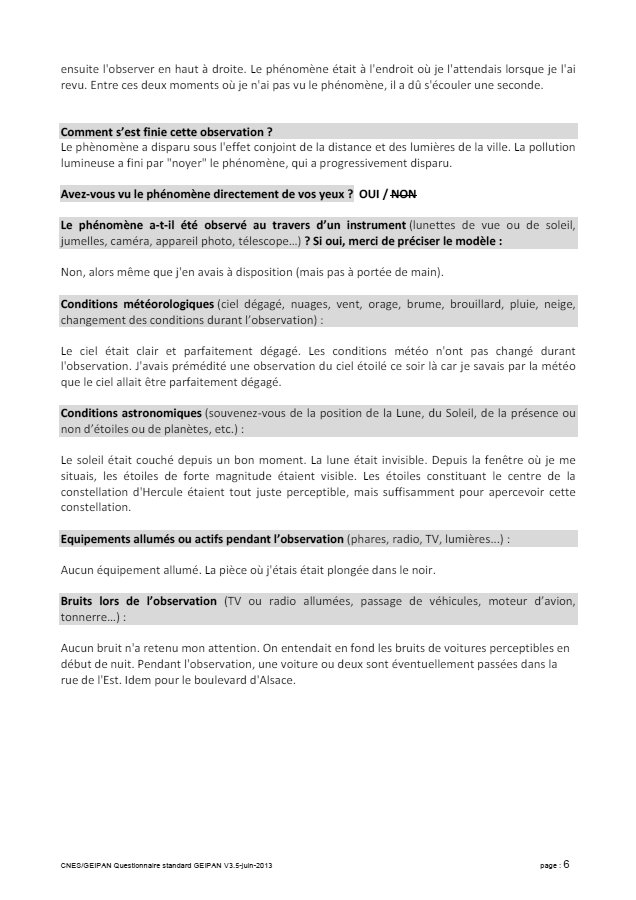
|
then observe it at the top right. The phenomenon was where I expected when I saw it again. Between these two moments when I did not see the phenomenon, one second must have passed.
How did this sighting end?
The phenomenon disappeared under the combined effect of distance and city lights. The light pollution ended up "drowning" the phenomenon, which gradually disappeared.
Did you see the phenomenon directly with your eyes? YES
Was the phenomenon observed through an instrument (spectacles or sunglasses, binoculars, camera, camera, telescope, etc.)? If yes, please specify the model:
No, even though I had some available (but not at hand).
Weather conditions (clear sky, clouds, wind, thunderstorm, haze, fog, rain, snow, change of conditions during observation):
The sky was perfectly clear. The weather conditions did not change during the observation. I had premeditated an observation of the starry sky that evening because I knew from the weather that the sky was going to be perfectly clear.
Astronomical conditions (remember the position of the Moon, the Sun, the presence or absence of stars or planets, etc.):
The sun had been down for quite a while. The moon was invisible. From the window where I was standing, stars of high magnitude were visible. The stars making up the center of the constellation Hercules were barely noticeable, but enough to see this constellation.
Equipment switched on or active during the observation (headlights, radio, TV, lights...):
No equipment turned on. The room I was in was pitch dark.
Noise during observation (TV or radio on, passing vehicles, aircraft engine, thunder, etc.):
No noise caught my attention. We heard in the background the noise of cars noticeable at the beginning of the night. During the sighting, a car or two may have passed on Rue de l'Est. Ditto for Boulevard d'Alsace.
CNES/GEIPAN Standard questionnaire GEIPAN V3.5-June-2013 page: 6
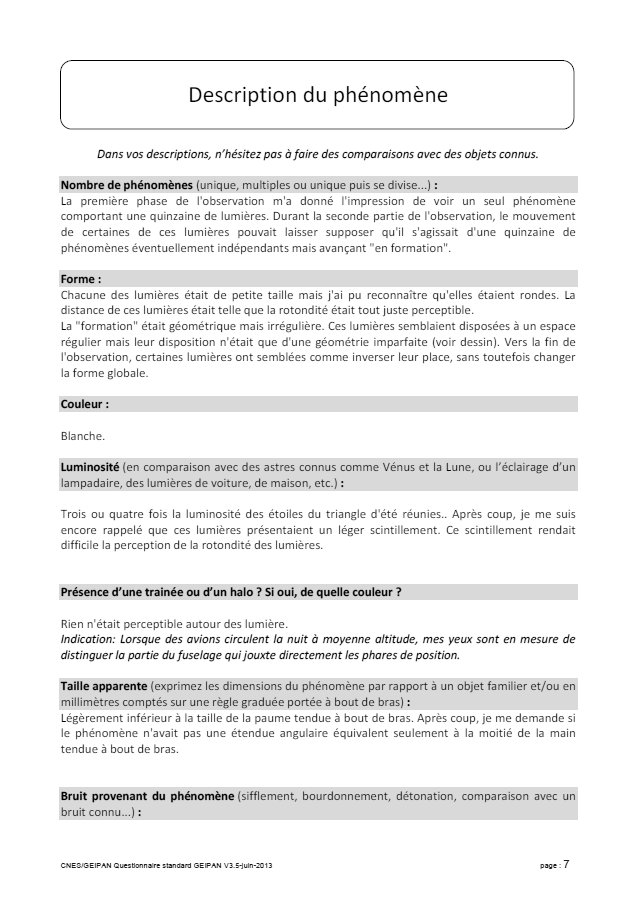
|
In your descriptions, do not hesitate to make comparisons with known objects.
Number of phenomena (single, multiple or single then splits...):
The first phase of the observation gave me the impression of seeing a single phenomenon comprising about fifteen lights. During the second part of the observation, the movement of some of these lights could suggest that it was about fifteen phenomena possibly independent but advancing "in formation".
Shape:
Each of the lights was small in size but I could tell they were round. The distance from these lights was such that the roundness was barely noticeable. The "formation" was geometric but irregular. These lights seemed arranged in a regular space but their arrangement was only of an imperfect geometry (see drawing). Towards the end of the observation, some lights seemed to reverse their place, without however changing the overall shape.
Color:
White.
Brightness (compared to known stars like Venus and the Moon, or lighting from street lamps, car lights, house lights, etc.):
Three or four times the brightness of the stars of the summer triangle combined. Afterwards, I still remembered that these lights had a slight twinkle. This flickering made it difficult to perceive the roundness of the lights.
Presence of a trail or a halo? If so, what color?
Nothing was noticeable around the lights.
Hint: When planes are taxiing at night at medium altitude, my eyes are able to make out the part of the fuselage directly adjacent to the position lights.
Apparent size (express the dimensions of the phenomenon in relation to a familiar object and/or in millimeters counted on a graduated ruler carried at arm's length):
Slightly smaller than the size of the outstretched palm at arm's length. Afterwards, I wonder if the phenomenon did not have an angular extent equivalent only to half of the outstretched hand at arm's length.
Noise from the phenomenon (hissing, buzzing, detonation, comparison with a known noise):
CNES/GEIPAN Standard questionnaire GEIPAN V3.5-June-2013 page: 7
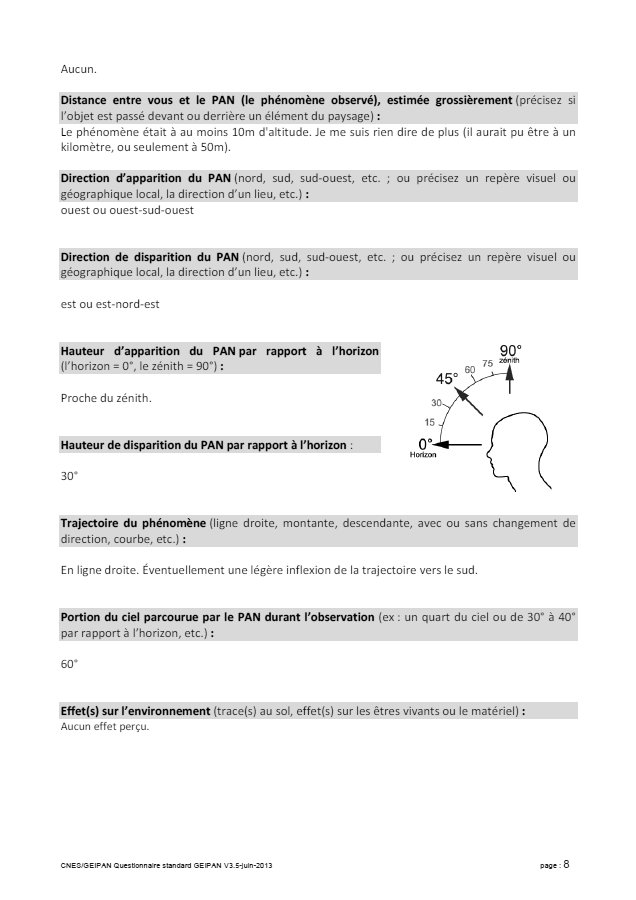
|
None.
Distance between you and the UAP (the observed phenomenon), roughly estimated (specify if the object passed in front of or behind an element of the landscape):
The phenomenon was at least 10m altitude. I didn't tell myself anything more (it could have been a kilometer away, or only 50m).
Direction of appearance of the UAP (north, south, southwest, etc.; or specify a local visual or geographical landmark, the direction of a place, etc.):
west or west-southwest
Direction of disappearance of the UAP (north, south, southwest, etc.; or specify a local visual or geographical landmark, the direction of a place, etc.):
east or east-northeast
Height of appearance of the UAP in relation to the horizon (the horizon = 0°, the zenith = 90°):
Close to the zenith.
Height of disappearance of the UAP in relation to the horizon:
30°
Trajectory of the phenomenon (straight line, rising, falling, with or without change of direction, curve, etc.):
In a straight line. Possibly a slight inflection of the trajectory towards the south.
Portion of the sky covered by the UAP during the observation (ex: a quarter of the sky or from 30° to 40° in relation to the horizon, etc.):
60°
Effect(s) on the environment (trace(s) on the ground, effect(s) on living beings or material):
No perceived effect.
CNES/GEIPAN Standard questionnaire GEIPAN V3.5-June-2013 page: 8
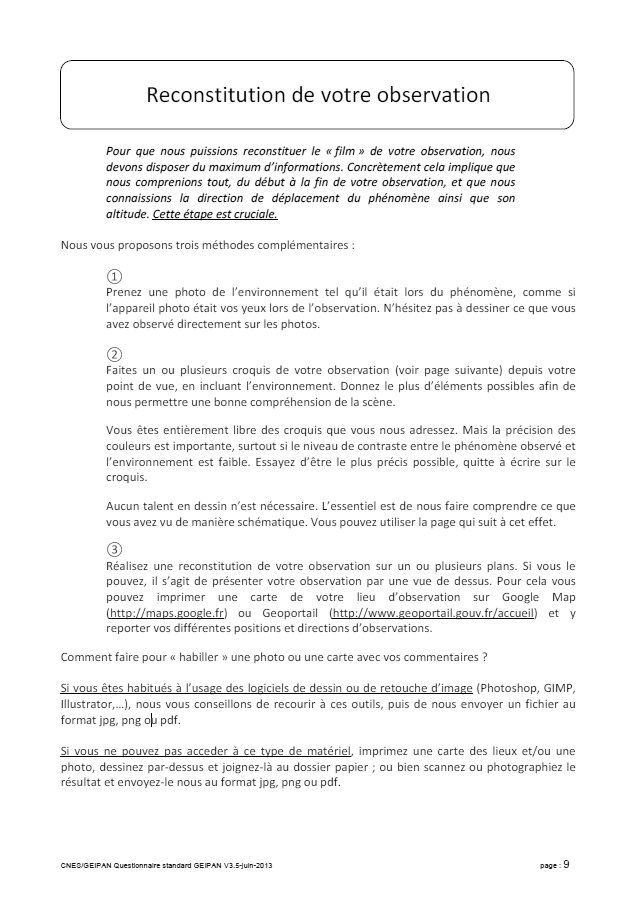
|
In order for us to reconstruct the "movie" of your sighting, we must have as much information as possible. Concretely, this implies that we understand everything, from the beginning to the end of your observation, and that we know the direction of movement of the phenomenon as well as its altitude. This step is crucial.
We offer three complementary methods:
How to "dress up" a photo or card with your comments?
If you are used to using drawing or image editing software (Photoshop, GIMP, Illustrator, etc.), we advise you to use these tools, then to send a file in jpg, png or pdf format.
If you cannot access this type of material, print a map of the location and/or a photo, draw over it and attach it to the paper file; or scan or photograph the result and send it to us in jpg, png or pdf format.
CNES/GEIPAN Standard questionnaire GEIPAN V3.5-June-2013 page: 9
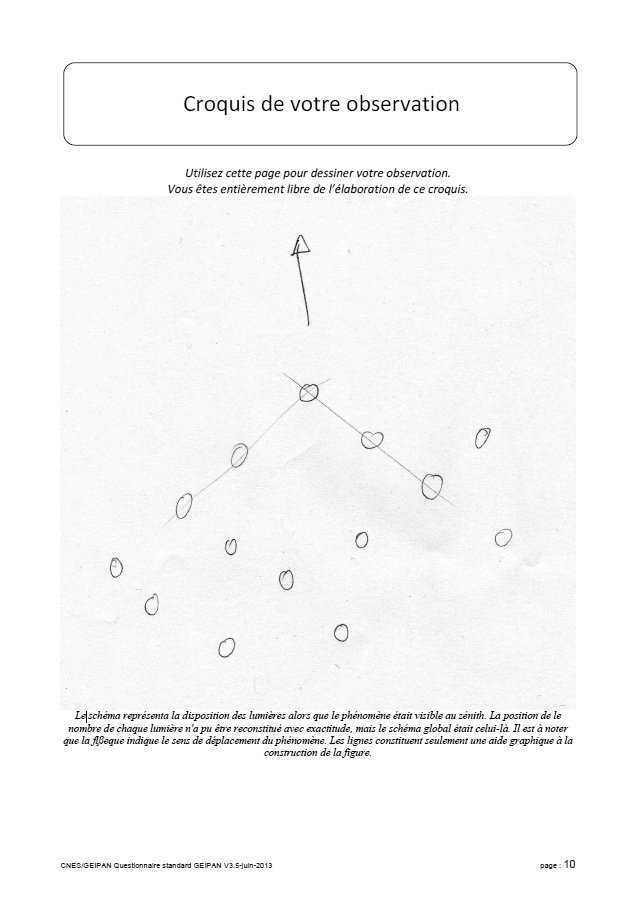
|
Use this page to draw your observation.
You are completely free to draw this sketch.
[Sketch.]
The diagram represents the arrangement of the lights while the phenomenon was visible at the zenith. The position of the number of each light could not be accurately reconstructed, but the overall pattern was that. It should be noted that the arrow indicates the direction of displacement of the phenomenon. The lines are only a graphical aid to the construction of the figure.
CNES/GEIPAN Standard questionnaire GEIPAN V3.5-June-2013 page: 10
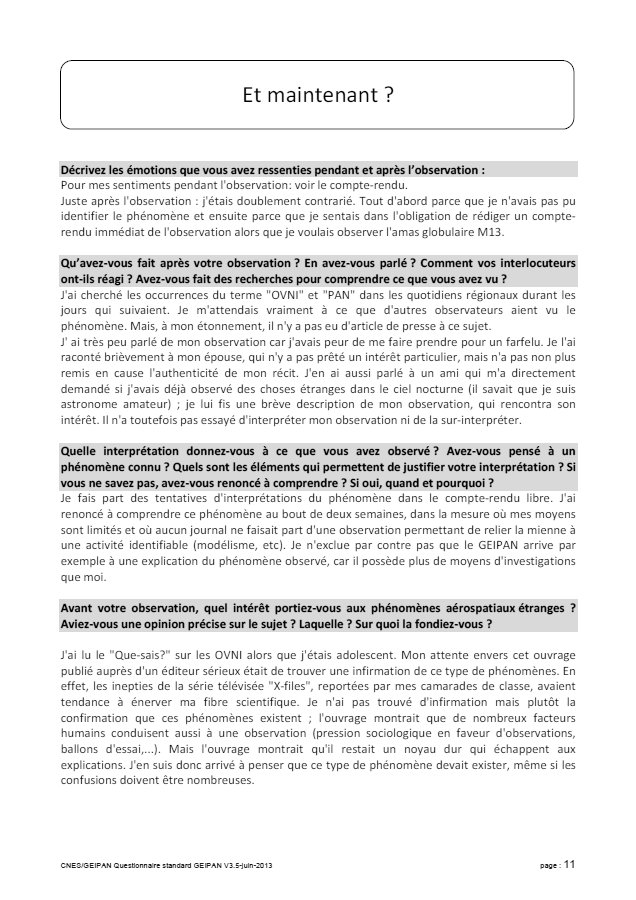
|
Describe the emotions you felt during and after the observation:
For my feelings during the sighting: see the report.
Right after the sighting: I was doubly upset. First of all because I had not been able to identify the phenomenon and then because I felt obliged to write an immediate account of the observation when I wanted to observe the globular cluster M13.
What did you do after your sighting? Did you talk about it? How did your interlocutors react? Did you do any research to understand what you saw?
I looked for occurrences of the term "UFO" and "UAP" in the regional dailies during the following days. I really expected other observers to have seen the phenomenon. But, to my surprise, there was no press article about it.
I said very little about my observation because I was afraid of being taken for a wacko. I told it briefly to my wife, who took no particular interest in it, but neither questioned the authenticity of my account. I also mentioned it to a friend who asked me directly if I had ever observed strange things in the night sky (he knew that I am an amateur astronomer); I gave him a brief description of my observation, which met his interest. He did not, however, try to interpret my observation or over-interpret it.
How do you interpret what you observed? Did you think of a known phenomenon? What are the elements that support your interpretation? If you don't know, have you given up on understanding? If yes, when and why?
I share the attempted interpretations of the phenomenon in the account. I gave up trying to understand this phenomenon after two weeks, insofar as my resources were limited and no newspaper reported an observation allowing me to link mine to an identifiable activity (model planes, etc.). On the other hand, I do not exclude that the GEIPAN arrives for example at an explanation of the observed phenomenon, because it has more means of investigation than I.
Before your observation, what interest did you have in strange aerospace phenomena? Did you have a specific opinion on the subject? Which one? What were you basing it on?
I read the "Que-sais?" about UFOs when I was a teenager. My expectation towards this book published by a serious editor was to find an invalidation of this type of phenomena. Indeed, the nonsense of the television series "X-files", reported by my classmates, tended to irritate my scientific fiber. I did not find any invalidation but rather confirmation that these phenomena exist; the book showed that many human factors also lead to an observation (sociological pressure in favor of observations, trial balloons, etc.). But the book showed that there remained a hard core that eludes explanation. So I came to think that this type of phenomenon must exist, even if there must be many misinterpretations.
CNES/GEIPAN Standard questionnaire GEIPAN V3.5-June-2013 page: 11
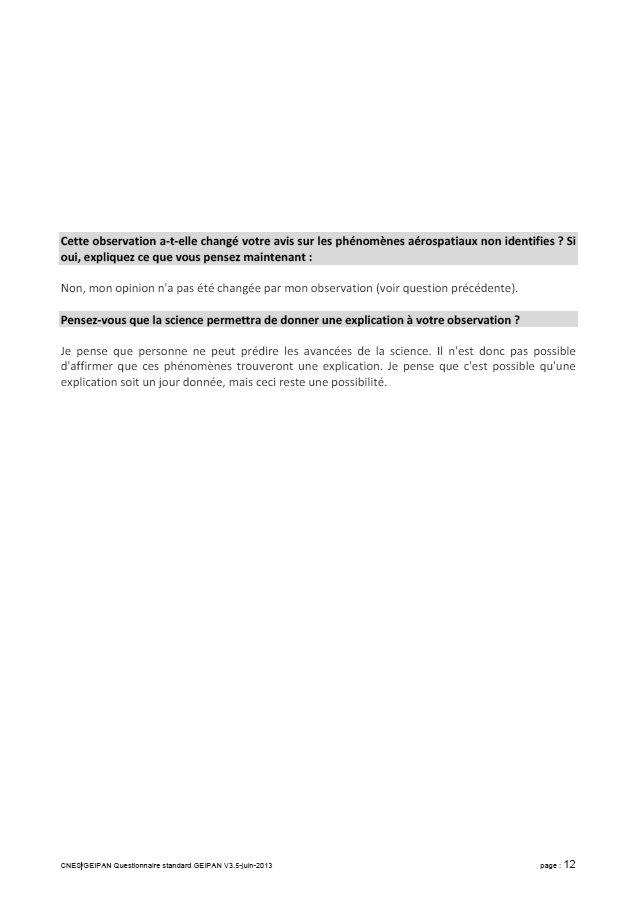
|
Did this observation change your opinion about unidentified aerospace phenomena? If so, explain what you think now:
No, my opinion did not change by my observation (see previous question).
Do you think science will provide an explanation for your observation?
I don't think anyone can predict advances in science. It is therefore not possible to affirm that these phenomena will find an explanation. I think it's possible that an explanation will be given one day, but this remains a possibility.
CNES/GEIPAN Standard questionnaire GEIPAN V3.5-June-2013 page: 12
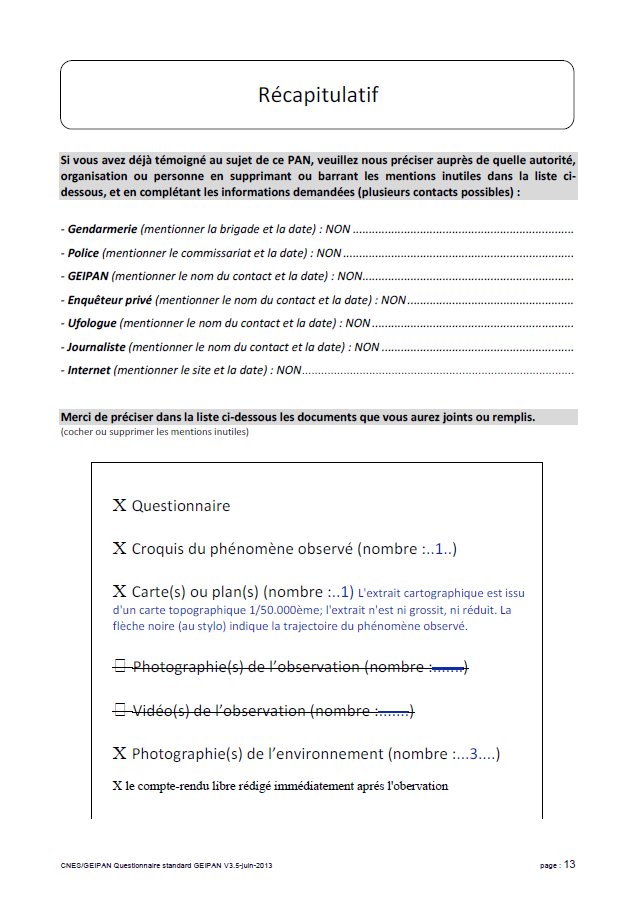
|
If you already testified about this UAP, please tell us with which authority, organization or person by deleting or crossing out the unnecessary mentions in the list below, and by completing the information requested (several contacts possible):
- Gendarmerie (mention the brigade and the date): NO ...
- Police (mention the police station and the date): NO ......
- GEIPAN (mention the name of the contact and the date): NO ...........
- Private investigator (mention contact name and date): NO ........
- Ufologist (mention the name of the contact and the date): NO ........
- Journalist (mention contact name and date): NO .....
- Internet (mention the site and the date): NO ........
Please specify in the list below the documents that you have attached or completed.
(check or remove unnecessary mentions)
(X) Form
(X) Sketch of the observed phenomenon (number:..1..)
(X) Map(s) or plan(s) (number:..1) The cartographic extract is taken from a 1/50,000th topographic map; the extract is neither magnified nor reduced. The black arrow (in pen) indicates the trajectory of the observed phenomenon.
( ) Photograph(s) of the sighting (number:.......)
( ) Video(s) of the sighting (number:.......)
(X) Photograph(s) of the environment (number:...3....)
(X) the free report written immediately after the observation
CNES/GEIPAN Standard questionnaire GEIPAN V3.5-June-2013 page: 13
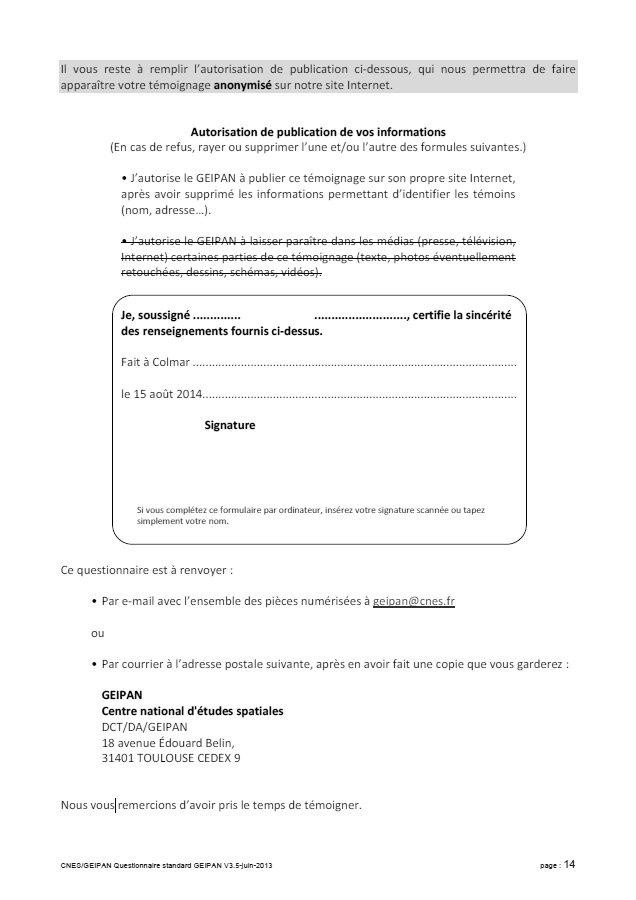
|
You still need to complete the publication authorization below, which will allow us to display your anonymized testimony on our website.
Authorization to publish your information (In case of refusal, cross out or delete one and/or the other of the following formulas.)
This questionnaire is to be returned:
- By e-mail with all the digitized parts to geipan@cnes.fr
or
- By mail to the following postal address, after having made a copy that you will keep:
GEIPAN
National Center for Space Studies
DCT/DA/GEIPAN
18 avenue Edouard Belin,
31401 TOULOUSE CEDEX 9
We thank you for taking the time to testify.
CNES/GEIPAN Standard questionnaire GEIPAN V3.5-June-2013 page: 14
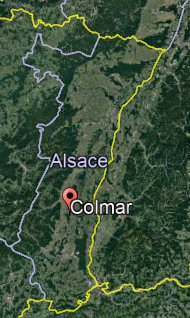
|
Of the two possibilities, Chinese lanterns or LED balloons, one is probably better than the other. The witness indicated:
A few weeks later, I remembered a detail: the lights had a slight flicker.
[...]
Afterwards, I also remembered that these lights had a slight flicker. This flickering made it difficult to perceive the roundness of the lights.
This flickering is typical of Chinese lanterns, typical of their flame. LED balloons have a strictly constant luminosity.
Chinese lanterns.
* = Source is available to me.
? = Source I am told about but could not get so far. Help needed.
| Main author: | Patrick Gross |
|---|---|
| Contributors: | None |
| Reviewers: | None |
| Editor: | Patrick Gross |
| Version: | Create/changed by: | Date: | Description: |
|---|---|---|---|
| 0.1 | Patrick Gross | September 3, 2022 | Creation, [ge1]. |
| 1.0 | Patrick Gross | September 3, 2022 | First published. |